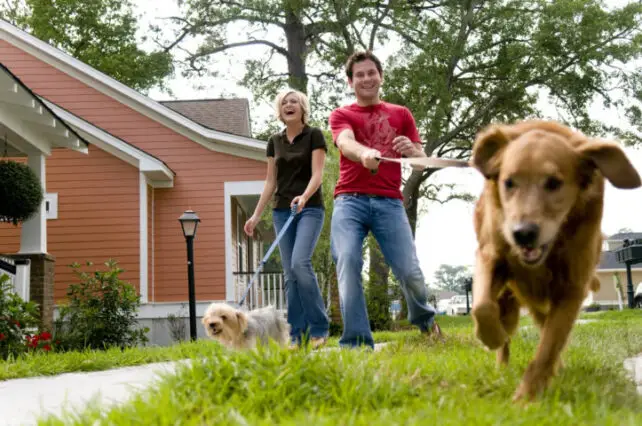The book Katz On Dogs is loaded with great tips for dog owners. It’s one of the first dog training books I bought when I got my third dog as a puppy.

The author, Jon Katz, is definitely someone who’s been there, done that! It’s clear that he’s speaking from years of experience.
He’s got just about every angle of dog ownership and dog behavior covered in this book:
- What kind of dog should I have? There are so many breeds and kinds.
- Can people work and have dogs?
- How often and for how long can they be left alone?
- Is it heartless to put a dog in a kennel?
- Should she come along on vacation?
- Will she miss us?
- Will she get lonely?
- DO dogs get lonely?
- Is it okay to have only one dog, or should he have company?
- But if he does, how can we handle a multi-dog household?
- Which training method is best?
- How to housebreak and socialize?
- Are choke chains and shock collars okay?
- Are crates cruel?
- Do I need to play alpha dog and show her who’s boss?
- Or should I be so positive that I never raise my voice?
- How can I exercise her in a lawsuit-crazy world where dogs are banned from almost every public place?
- How can I walk her instead of having her walk me?
- Does she need extracurricular activities?
- What’s normal, natural behavior for a dog, and what’s aberrant?
- Should he have a vegan diet? Or an organic one?
- See ordinary vets or holistic and other alternative practitioner?
- How can I teach him to be appropriate with people and other dogs?
- How do we know if he’s aggressive?
- What if he bites somebody?
- Is it cruel to find a new home for a dog that isn’t happy and is driving me crazy?
- What are our dogs thinking, anyway?
- Are they really members of our family, children with fur?
- Can they really love and understand us, read our minds, know our moods?
- What is at the heart of this profoundly rich, ancient connection, the human-canine bond, perhaps the closest we humans will ever forge with another species?
- What problems from our own lives do we bring to our relationships with dogs?
- Can we train and understand dogs without understanding ourselves?
- How can we manage the dog love many of us feel – a powerful social and cultural force – yet keep our human lives in balance?
- As we love dogs in more complicated ways and find separating from them increasingly difficult, one of the most fraught questions will inevitably arise: When should their lives end?
It’s true… dog lovers face so many decisions throughout their dog’s life. And those are some of the most pressing questions which Katz talks about in this book — all very useful and helpful to a dog owner.
Why I Bought This Book
I first heard about this book from the Bob & Tom Show. The author, Jon Katz, was being interviewed by Bob & Tom, and it was obvious that he had a really good sense of humor.
I could tell right away that he was down-to-earth… and funny. From that interview alone, I made a mental note to buy his book, Katz on Dogs.
I bought the book for the purpose of using it as a reference guide — an instruction manual for living with dogs, so to speak.
It’s definitely a book that I am very thankful I’ve read!
There’s a wealth of good advice for dog owners who want “do the right thing” without having to go through all the “wrong ways” first themselves.
I’ve also found a lot of great “talking points” in this book… ideas that I’ve enjoyed discussing with my friends who have dogs.
Lots of times when I’m chatting with fellow dog owners, I find myself referring to something I read in this book. (Which reminds me that Katz on Dogs would make a great gift for someone who is thinking about getting a dog or has recently obtained a new dog.)
Reasons To Read This Book
It’s clear that much of what Katz knows about dogs he learned the hard way.
As a result, he offers a number of pointers to guide you down the right path with your dog, saving you a lot of time and energy from doing things “wrong”.
You’ll see what to avoid, as well as what to consider when it comes to living peacefully with a dog inside your home.
A wide variety of circumstances are covered — including basic dog behavior, dog tricks & training, food & feeding issues, and just good ‘ol practical ideas that you might want to try.
Overall, I think this is a wonderful book for a new dog owner — whether its your first dog, or your fifth.
My Favorite Takeaways From The Book
Katz on Dogs contains a lot of storytelling, where the author recalls several of his own personal experiences of training and living with dogs.
This is helpful for clarifying the circumstances surrounding a particular situation and illustrating the dog owner’s behaviors, as well as the dog’s. But, quite honestly, I often skimmed over his long-winded commentaries in order to jump right to the point.
Personally, I prefer to leave storytelling for around the campfire and for one-on-one conversations with fellow dog owners. But this is true with most of the books that I read. I crave the practical, easy-to-follow tips and how-to’s most of all.
Thankfully, this book is loaded with great tips and practical guidelines! And that’s why I enjoyed reading it so much.
The #1 tip I took away from reading this book is never set your dog up to fail. I have incorporated that mantra in every dog training scenario that I’ve done since then.
Here are some of the other “takeaways” — my favorite points that Katz makes in the book:
I have a puppy whose intensity could easily have made her impossible to live with as a pet … We’ve struck a contract: I will show her how to live in the world; she will give back much more.
One only has to look at any park and see sheepdogs obsessed with Frisbees, frantic, out of control Labs, plus poorly trained rescue and shelter adoptees to know how enormous a struggle it is to live well with a dog, how easy it is to mess up these extraordinary creatures.
I’ve often screwed up, and still do regularly, and so do my dogs, but we never quit on each other.
One training study conducted by a veterinary pharmaceutical company found that of people who do attempt to train their dogs, more than 90% fail to meet their initial goals.
According to veterinary association statistics, only about 3-5% of Americans train their dogs at all. And those who do often quit along the way, and for understandable reasons. They are frustrated and confused.
All 3 of my dogs arrived knowing how to do many things – run, bark, eat, chew, squabble, chase. None of them knew how to do nothing, how to remain calm and at ease. To stay and wait. In some ways, that may be the most valuable thing I’ll ever teach them.
Some positive trainers consider it nearly abusive to ever yell at a dog. I probably yell at my dogs 2 or 3 times a day, depending on what drama is unfolding at the moment. I yell. They come. Yet almost all of my formal training is entirely positive, my instructions reinforced with praise and treats and much whooping enthusiasm.
I also accept some elements of pack, or dominance, training. I have to be the leader — not the boss — of my dogs.
Getting dogs to submit is not so difficult, I’ve found. After all, I control access to outdoors, food and treats, and toys, all the desirable things. I can dominate my dogs through rules and leadership.
I love psychologist and author Stanley Coren’s wise edict: Never give a dog anything for free. Before we go anywhere, before they get any treat, the dogs must lie down, sit, come, or stay, an organic form of training woven into our daily walks, meals, and routines. I see it as a toll; I charge my dogs for everything. Lie down outside the door, get a treat, then tear around. Lie down at the road, get a treat, then dash across on command.
When we go out in the morning, they lie down and wait until I’ve put my coat on. When I say, “Let’s go out,” if they rush toward the door, I stop, have them back up and lie down again; I wait until they are calm before we proceed. When I put their food bowls down, I first make them sit and wait. Maybe I make the coffee. Then I release them to eat. I’m not trying to be prissy or iron-fisted, only to keep things orderly — especially since I’ve chosen to live with 3 dogs. When your dog is pushing, you have a training problem. Push back, clearly and consistently.
The point isn’t to have spit-and-polish dogs who obey with military precision; I certainly don’t. It’s to establish leadership and promote respectful submission by using the things they like to do as reinforcement for things I want them to do. I set the rules and they follow most of them and are rewarded, with minimal scolding, no shocking or whacking.
If our dogs — who have phenomenal hearing — aren’t listening, it’s because of what we’re saying or the tone and volume with which we’re saying it.
“Obedience” is a lousy word to describe training, which is mostly about communicating.
Dogs are not aware of time, even as a concept. So “Blue” couldn’t know whether she was being left for 5 minutes or 5 hours, or how that compared to being left for a movie 2 weeks earlier.
The more I’ve moved away from interpreting my dogs’ behavior as nearly human, the easier it is to train them, and the less guilt and anxiety I feel.
Before I ask a new dog to obey me, I want him or her to know, trust, and like me. That means weeks of asking little, offering much. Hand-feeding is one of my favorite techniques for encouraging bonding with a puppy or new dog. Simply, I feed the dog his or her food from my hand, a half-cup at a time, sometimes one individual bit of kibble after another. Usually I sit on the floor, holding food out. When the dog comes running, I hold the food up by my eyes, so the dog gets used to making eye contact. Then, while the dog is eating, I repeat her name. If you hand-feed a dog for a few months while saying her name (half the time, I put food in the dog’s crate to make her appreciate that, too), I can almost guarantee that the dog will know its name, pay attention to you, and be more receptive to what you ask.
Behaviorists say it can take up to 2,000 repetitions before a dog really understands a behavior. Very few people hang in there that long, underestimating the extended, consistent nature of good training. Americans are impatient, geared toward quick fixes and instant rewards.
Aren’t those wonderful “gems” of wisdom to remember when it comes to training dogs?
In addition to all of the takeaways, his explanations and examples throughout the book make dog training much easier, in my opinion.
The book Katz on Dogs helped me a lot and I think it will help you too!
Other Great Dog Training Books
- The Art Of Raising A Puppy
- A Visual Guide Book For Training Dogs
- Training Little Dogs
- On Talking Terms With Dogs: Calming Signals
- The Complete Idiot’s Guide To Positive Dog Training
- Puppy Training Guide
- Training The Best Dog Ever: A 5-Week Program
I like to help Dog Parents find unique ways to do things that will save time & money — so I write about “outside the box” Dog Tips and Dog Hacks that most wouldn’t think of. I’m a lifelong dog owner — currently have 2 mixed breed Golden Aussies that we found abandoned on the side of the road as puppies. I’ve always trained my own dogs and help friends train theirs, as well. Professionally, I worked at a vet and have several friends who are veterinarians — whom I consult with regularly. (And just because I love animals so much, I also worked at a Zoo for awhile!) I’ve been sharing my best ideas with others by blogging full-time since 1998 (the same year that Google started… and before the days of Facebook and YouTube). My daily motivation is to help first-time dog owners be better prepared from the first day your new puppy enters your home. I like to help dog owners understand what’s ‘normal’ and what you can expect in terms of living with and training your dog — how to get through the ups & downs of potty training, chewing, teaching commands, getting your dog to listen, and everything else that takes place during that hectic first year! When I’m not training, walking, grooming, or making homemade treats for my dogs, you will find me at the corner of Good News & Fun Times as publisher of The Fun Times Guide (32 fun & helpful websites). To date, I’ve written over 600 articles for dog owners on this site! Many of them have upwards of 200K shares.










